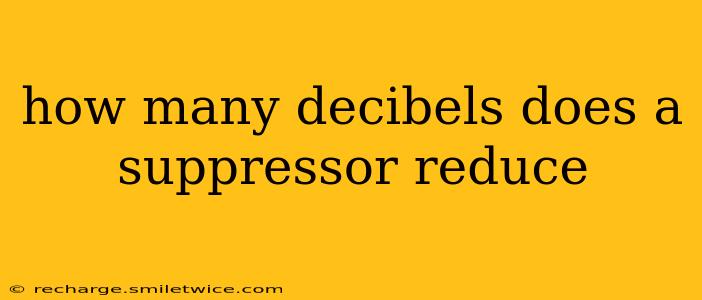How Many Decibels Does a Suppressor Reduce? The Complex Answer to a Simple Question
The question of how many decibels a suppressor reduces is deceptively simple. The answer, unfortunately, isn't a single number. The sound reduction provided by a suppressor, also known as a silencer, varies significantly depending on several crucial factors. This article will delve into these factors and provide a more nuanced understanding of suppressor effectiveness.
Understanding Decibel Reduction and Sound Measurement
Before exploring the variables affecting decibel reduction, it's vital to understand how sound is measured. Sound is measured in decibels (dB), a logarithmic scale. This means that a 10 dB reduction represents a tenfold decrease in sound intensity, and a 20 dB reduction represents a hundredfold decrease. While a suppressor can significantly reduce the perceived loudness of a firearm, it rarely silences it completely.
What Factors Influence Suppressor Decibel Reduction?
Several interconnected factors significantly influence the amount of sound reduction a suppressor provides:
-
Caliber of the Firearm: Larger calibers generally produce louder reports, making it more challenging for a suppressor to achieve the same level of sound reduction compared to smaller calibers. A .22LR will experience a greater percentage reduction than a .300 Win Mag, even with the same suppressor design.
-
Cartridge Type: Different ammunition types, even within the same caliber, generate varying levels of sound. Subsonic ammunition, designed to travel slower than the speed of sound, inherently produces less noise than supersonic ammunition. Suppressors are significantly more effective at reducing the sound of subsonic ammunition.
-
Suppressor Design and Construction: Suppressor designs vary considerably. Different materials, baffle configurations, and overall lengths all impact their effectiveness. High-quality suppressors generally offer greater sound reduction.
-
Firearm Host: The firearm's design and barrel length can influence how effectively a suppressor works. Some firearms are better suited for suppressor use than others.
-
Shooting Environment: The surrounding environment, including the presence of reflective surfaces, significantly influences how much noise reduction is perceived.
Typical Decibel Reduction Ranges
While a precise number is impossible to give, suppressors generally reduce the sound of a firearm by 30-40 dB, depending on the factors mentioned above. This significant reduction is still enough to make the firearm substantially quieter and to reduce the risk of hearing damage to the shooter.
How Much Does a Suppressor Reduce the Sound of a .22LR?
A suppressor can often reduce the sound of a .22LR by a significant amount, sometimes exceeding 40 dB, especially when used with subsonic ammunition. This makes it much quieter than an unsuppressed .22LR.
How Much Does a Suppressor Reduce the Sound of a Rifle?
Suppressor effectiveness on rifles varies substantially depending on the caliber and ammunition used. Generally, you can expect a reduction in the 30-40 dB range, but this can be less with larger calibers and supersonic ammunition.
Does a Suppressor Make a Gun Silent?
No, a suppressor does not make a gun completely silent. While it significantly reduces the sound, the report of the firearm will still be audible. Think of it as significantly muffling the sound rather than eliminating it entirely.
Conclusion
Determining the exact decibel reduction of a suppressor requires specific testing with the firearm, ammunition, and suppressor in question. The information provided here gives a general idea of the sound reduction achievable. Always prioritize safety and consult relevant regulations when using suppressors. Remember that even with a suppressor, hearing protection is still strongly recommended.
